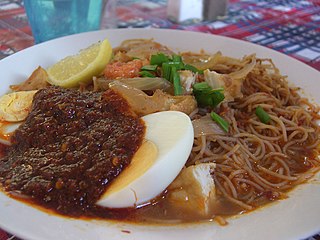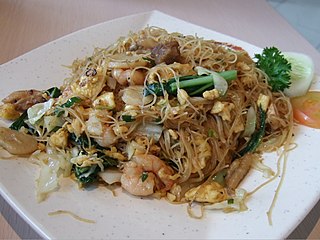
Satay, or sate in Indonesian spelling, is a Southeast Asian form of kebab made from seasoned, skewered and barbecued meat, served with a sauce.

Indonesian cuisine is a collection of various regional culinary traditions that formed in the archipelagic nation of Indonesia. There are a wide variety of recipes and cuisines in part because Indonesia is composed of approximately 6,000 populated islands of the total 17,508 in the world's largest archipelago, with more than 1,300 ethnic groups.

Malay cuisine is the traditional food of the ethnic Malays of Southeast Asia, residing in modern-day Malaysia, Indonesia, Singapore, Brunei, Southern Thailand and the Philippines as well as Cocos Islands, Christmas Island, Sri Lanka and South Africa.

Singaporean cuisine is derived from several ethnic groups in Singapore and has developed through centuries of political, economic, and social changes in the cosmopolitan city-state.

Mee siam is a dish of thin rice vermicelli of hot, sweet and sour flavours, originated in Penang but popular among the Malay and Peranakan communities throughout Peninsular Malaysia and Singapore, although the dish is called "Siamese noodle" in Malay and thus appears to be inspired or adapted from Thai flavours when Thailand was formerly known as Siam. Mee siam is related to kerabu bee hoon although there is a significant difference in the recipe.
Ipoh has a significant food scene with many hawker centres and restaurants. It has dishes derived from Malay, Chinese and Indian cuisine.

Chinese Indonesian cuisine is characterized by the mixture of Chinese with local Indonesian style. Chinese Indonesians, mostly descendant of Han ethnic Hokkien and Hakka speakers, brought their legacy of Chinese cuisine, and modified some of the dishes with the addition of Indonesian ingredients, such as kecap manis, palm sugar, peanut sauce, chili, santan and local spices to form a hybrid Chinese-Indonesian cuisine. Some of the dishes and cakes share the same style as in Malaysia and Singapore, known as Nyonya cuisine by the Peranakan.

Rice vermicelli is a thin form of noodle. It is sometimes referred to as "rice noodles" or "rice sticks", but should not be confused with cellophane noodles, a different Asian type of vermicelli made from mung bean starch or rice starch rather than rice grains themselves.

Rice noodles, or simply rice noodle, are noodles made with rice flour and water as the principal ingredients. Sometimes ingredients such as tapioca or corn starch are added in order to improve the transparency or increase the gelatinous and chewy texture of the noodles. Rice noodles are most common in the cuisines of China, India and Southeast Asia. They are available fresh, frozen, or dried, in various shapes, thicknesses and textures. Fresh noodles are also highly perishable; their shelf life may be just several days.

Peanut sauce, satay sauce, bumbu kacang, sambal kacang, or pecel is an Indonesian sauce made from ground roasted or fried peanuts, widely used in Indonesian cuisine and many other dishes throughout the world.

Lontong is an Indonesian dish made of compressed rice cake in the form of a cylinder wrapped inside a banana leaf, commonly found in Indonesia, Malaysia, and Singapore. Rice is rolled inside a banana leaf and boiled, then cut into small cakes as a staple food replacement for steamed rice. The texture is similar to that of ketupat, with the difference being that the ketupat container is made from woven janur fronds, while lontong uses banana leaf instead.

Javanese cuisine is the cuisine of Javanese people, a major ethnic group in Indonesia, more precisely the province of Central Java, Yogyakarta and East Java.

Singapore-style noodles is a dish of stir-fried cooked rice vermicelli, curry powder, vegetables, scrambled eggs and meat, most commonly char siu pork, and/or prawn or chicken.

Ketoprak is an Indonesian vegetarian dish from Jakarta, consisting of tofu, vegetables, rice cake, and rice vermicelli served in peanut sauce.
Crab bee hoon is a Singaporean rice vermicelli dish with whole mud crab served in a claypot and spiced milky broth. Bee Hoon or rice noodle has the ability to soak up the stock from any dish and that's the reason it is so popular among the locals. There's also a dry version, where thinner rice noodles are tossed in a hot wok before stewing in a broth until every strand is permeated with similar sweetness.

Indonesian noodles are a significant aspect of Indonesian cuisine which is itself very diverse. Indonesian cuisine recognizes many types of noodles, with each region of the country often developing its own distinct recipes.

Bihun goreng, bee hoon goreng or mee hoon goreng refers to a dish of fried noodles cooked with rice vermicelli in both the Indonesian and Malay languages. In certain countries, such as Singapore, the term goreng is occasionally substituted with its English equivalent for the name of the dish.













